Persian Rice with Crispy Tahdig is undoubtedly the most delicious and popular dish in Persian cuisine. Think of fluffy rice which is then flipped upside down to reveal a crispy golden crust at the top which we call Tahdig!
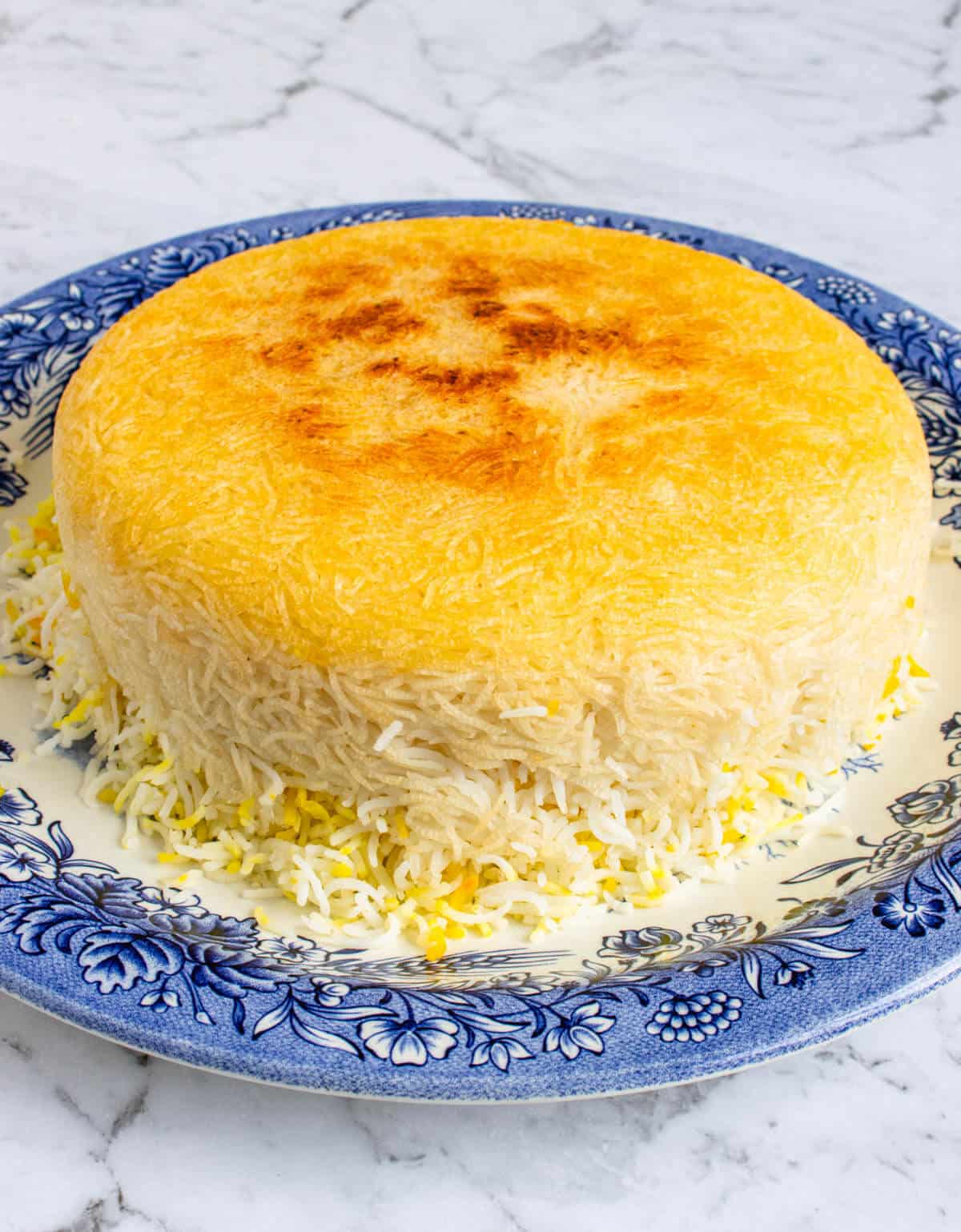
Persian rice is a staple in Persian cuisine. Growing up Persian, rice is something we eat with almost every dish. The method of double cooking and steaming the rice is a signature step in making the rice beautifully fluffy and light.
It's generally served with a Persian stew such as Khoresh Bademjan which is an Eggplant stew and one of my favorites!
We do have many different versions of Persian rice dishes such as Sabzi Polo which is layered with fresh herbs. In other dishes we use yogurt for the base and saffron, and sometimes we top it with sliced pistachios or almonds. In this recipe, I'll be showing you the classic version which we use as the base in our cooking.
A popular dish we serve as an appetizer in Persian cuisine is an eggplant dip called Kashke Bademjan alongside Shirazi Salad.
The Tahdig however is of course the star of the show!! We flip the rice pot upside down on a platter, like a cake! The pot is then lifted up which will present a golden and crispy top….. heaven!
Table of Contents
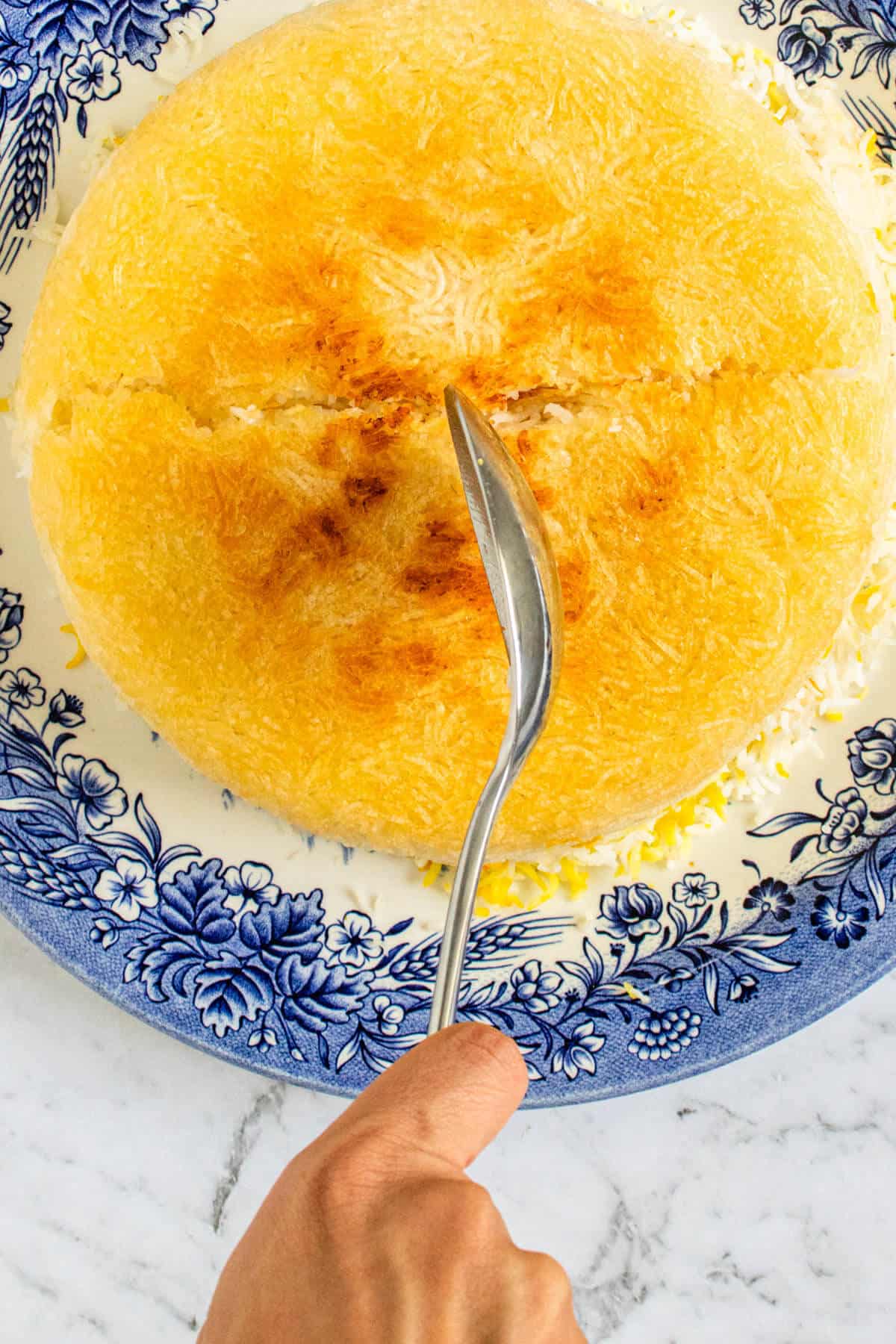
What is Tahdig?
Pronounced "Tah-dig" actually translates to 'the bottom of the pot' in Farsi, a very popular staple in Persian cuisine. We literally flip the rice pot upside down on a platter, like a cake!
The pot is then lifted up which will present a golden crispy layer on the top of the rice that is everyone’s favourite part!
Tahdig can be made in many ways. The classic way is using rice like this recipe but we can also use sliced potato, flatbread, and even use plain yogurt to make a different style of tahdig. One of my favourite ways to make tahdig is when making Makaroni which is Persian Spaghetti
When Tahdig is made it's then cut into even pieces before being served. It’s always a tradition to make sure everyone at the table has received their piece before going for seconds. Oh, I promise you will want seconds of this, there’s never enough Tahdig to be eaten!
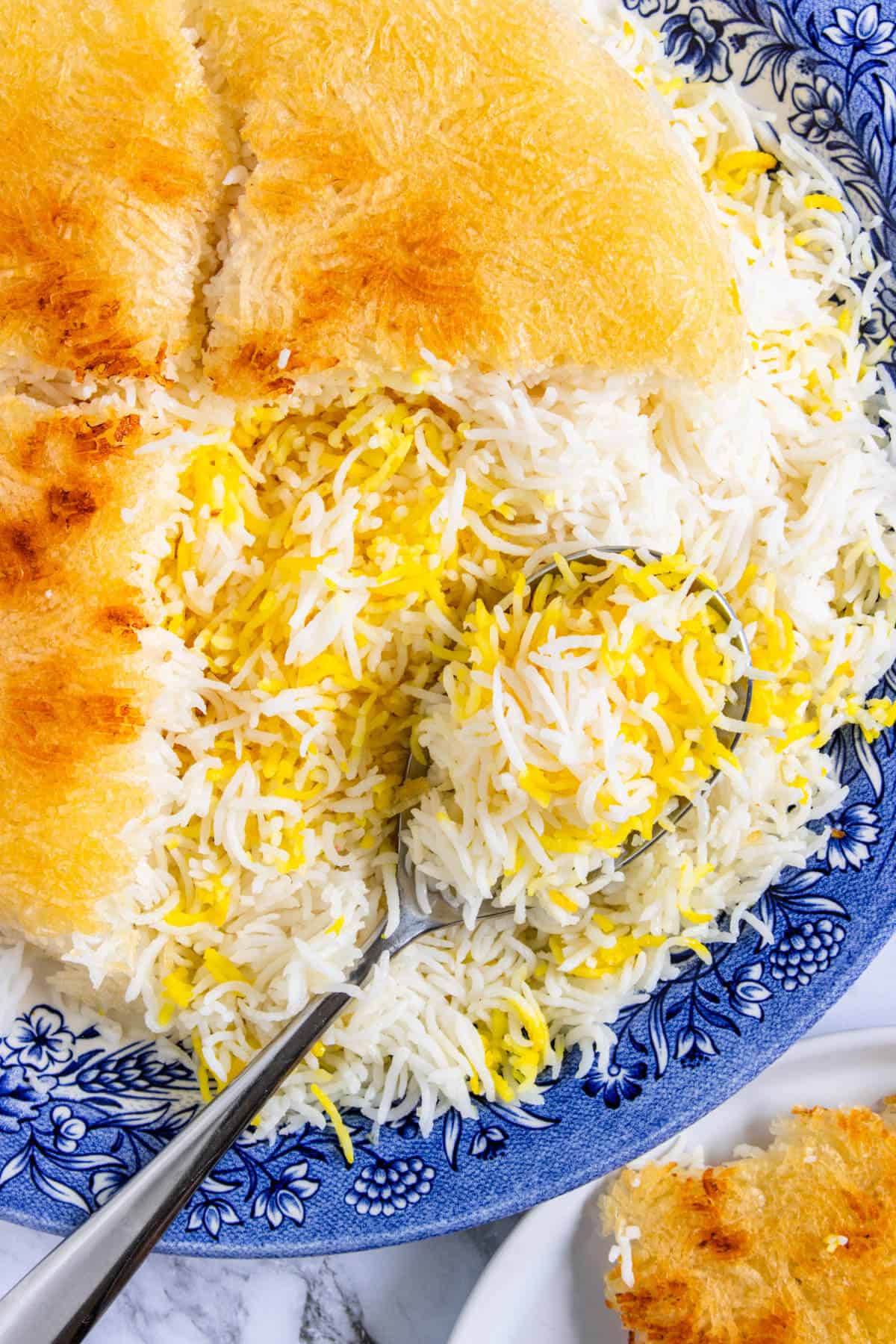
Ingredients to make Persian Rice with Crispy Tahdig
- Rice of course is the star! The most common and traditional rice to use is basmati rice. Use the best quality for the best flavor. I usually try to use Indian basmati rice. You can however also use long-grain rice or any white rice also
- Salt is added to the boiling process of the rice for flavour. Once the rice is drained and rinse, any excess salt will be washed away
- Extra virgin olive oil is what I prefer to use. You can use any oil that you prefer such as avocado oil or even vegetable oil. Melted butter is also commonly used
- Saffron is a key ingredient in making Iranian rice and many Persian dishes for its lovely aroma ,flavour and colour. If you don't have access to it, not to worry as you can make it without it
- Potato or Flatbread can be used for the Tahdig. You can use flatbread such as lavash, Lebanese bread or Pita bread. If using the potato, peel it and slice thinly.
Potato Tahdig
Did you know you can make Tahdig with Potatoes??? Yep Crispy Potatoes!! It’s one of my absolute favourite Tahdig variations and it’s so easy to make!
All you have to do is peel a potato, and slice into thin even slices. When layering the pot, add the oil then add a layer of the sliced potatoes. You then add back the rest of the rice and allow to cook nice and slow on a low heat for 45 minutes and BOOM…. Crispy Potato Tahdig
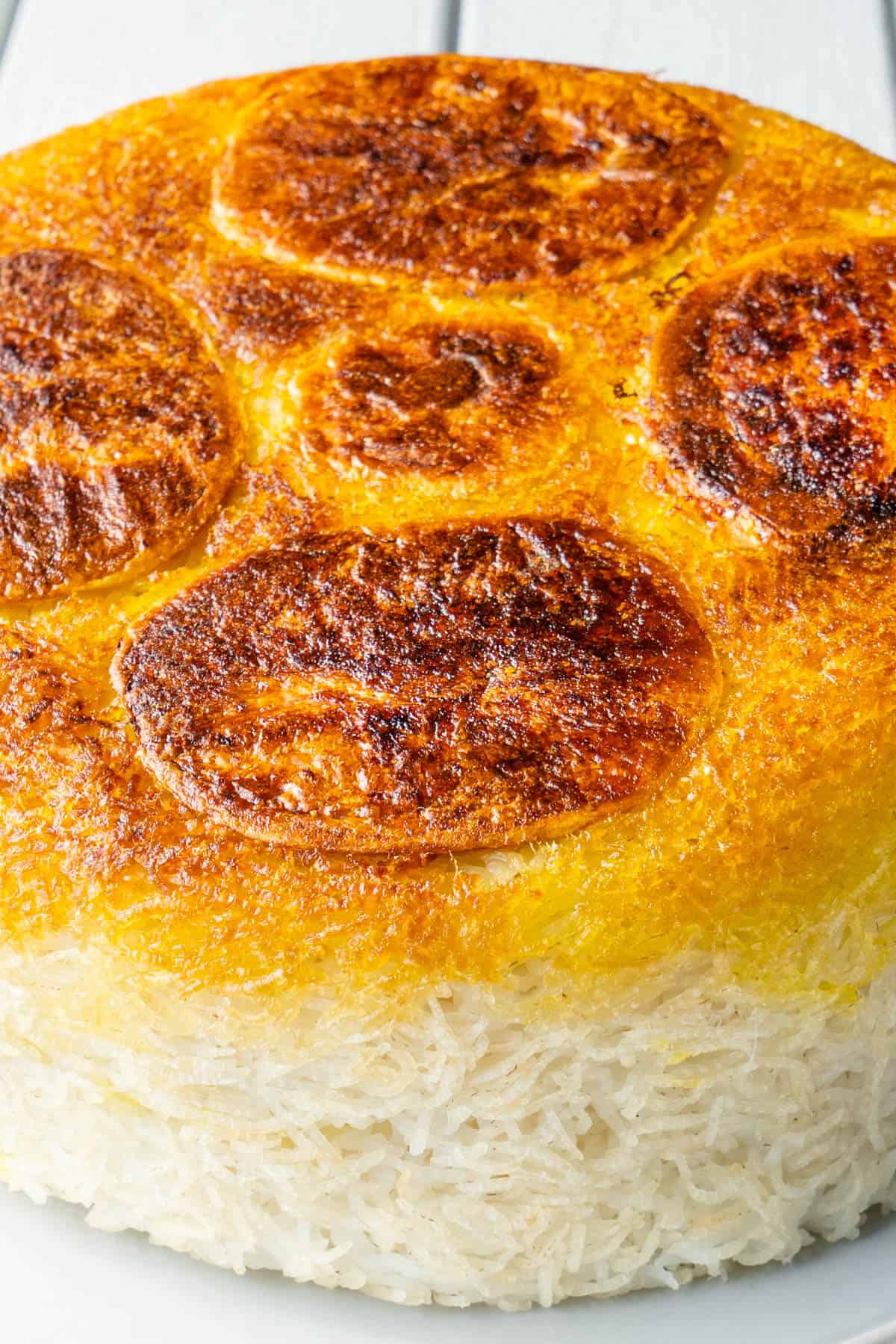
How to make Persian Rice with Crispy Tahdig
The secret in making Persian Rice perfect is ensuring each step is taken with care. These are my simple steps which work everytime.
Parboil Rice
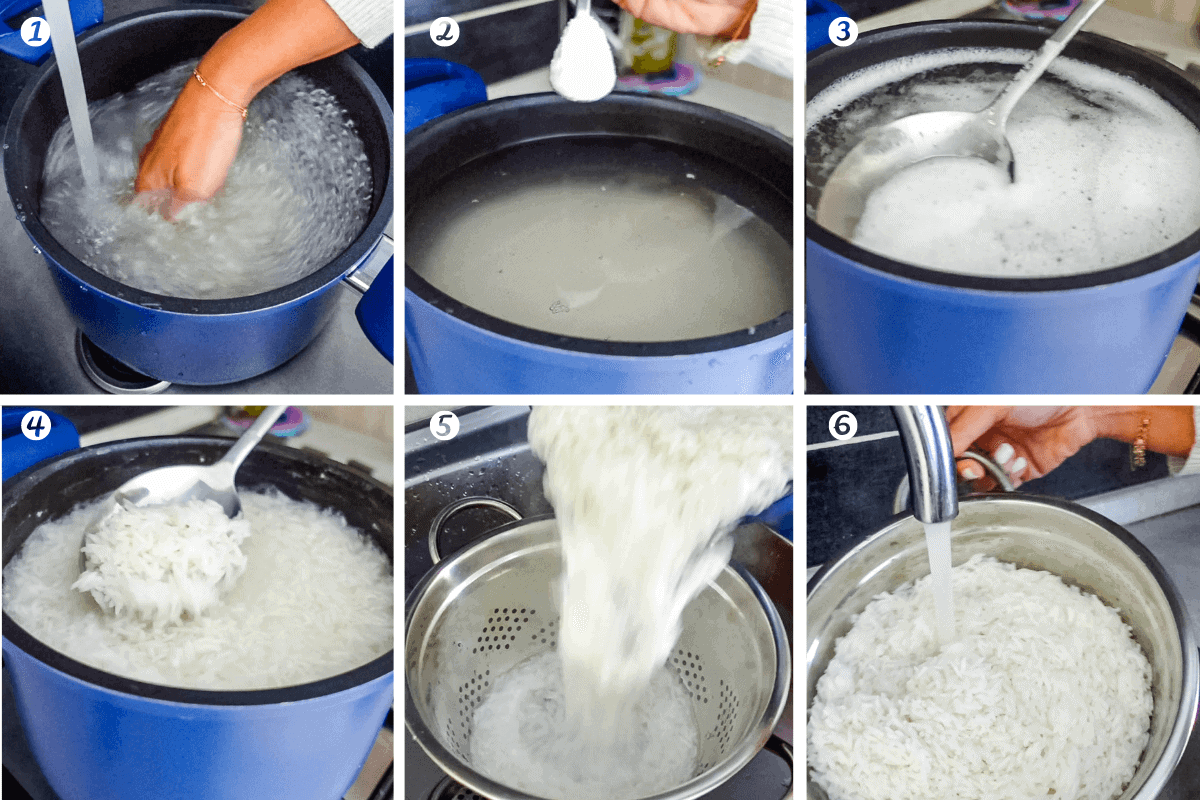
- Wash rice 4 to 5 times until water runs clear without mist
- Fill pot with water and add salt Boil on a medium-high heat 10-15 minutes
- Carefully spoon out and disregard any white foam on the top
- Check that rice is cooked to aldente with a slight bite to it
- Drain rice through a colander
- Rinse under cold water with low water pressure
Steam Rice
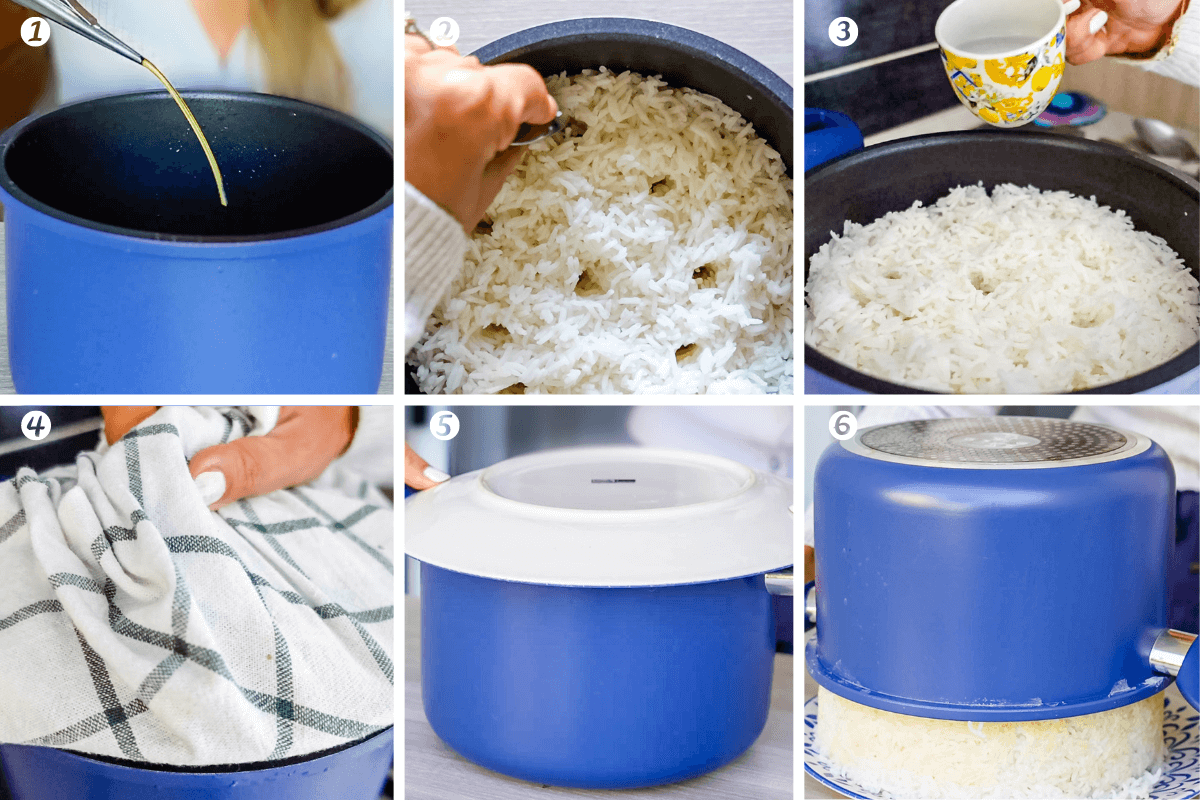
- Add a generous amount of olive oil to the bottom of the pot
- Add the parboiled remaining rice back to the pot. Use the handle of a tablespoon to make holes in the rice to the bottom of the pot
- Add a splash of water
- Wrap the lid with a clean kitchen towel and place the lid on. Cook on the low heat for 45 minutes
- Remove the lid and place a large plate on the pot and flip the pot upside down
- Carefully lift the pot and reveal your beautiful Persian Rice with Crispy Tahdig!
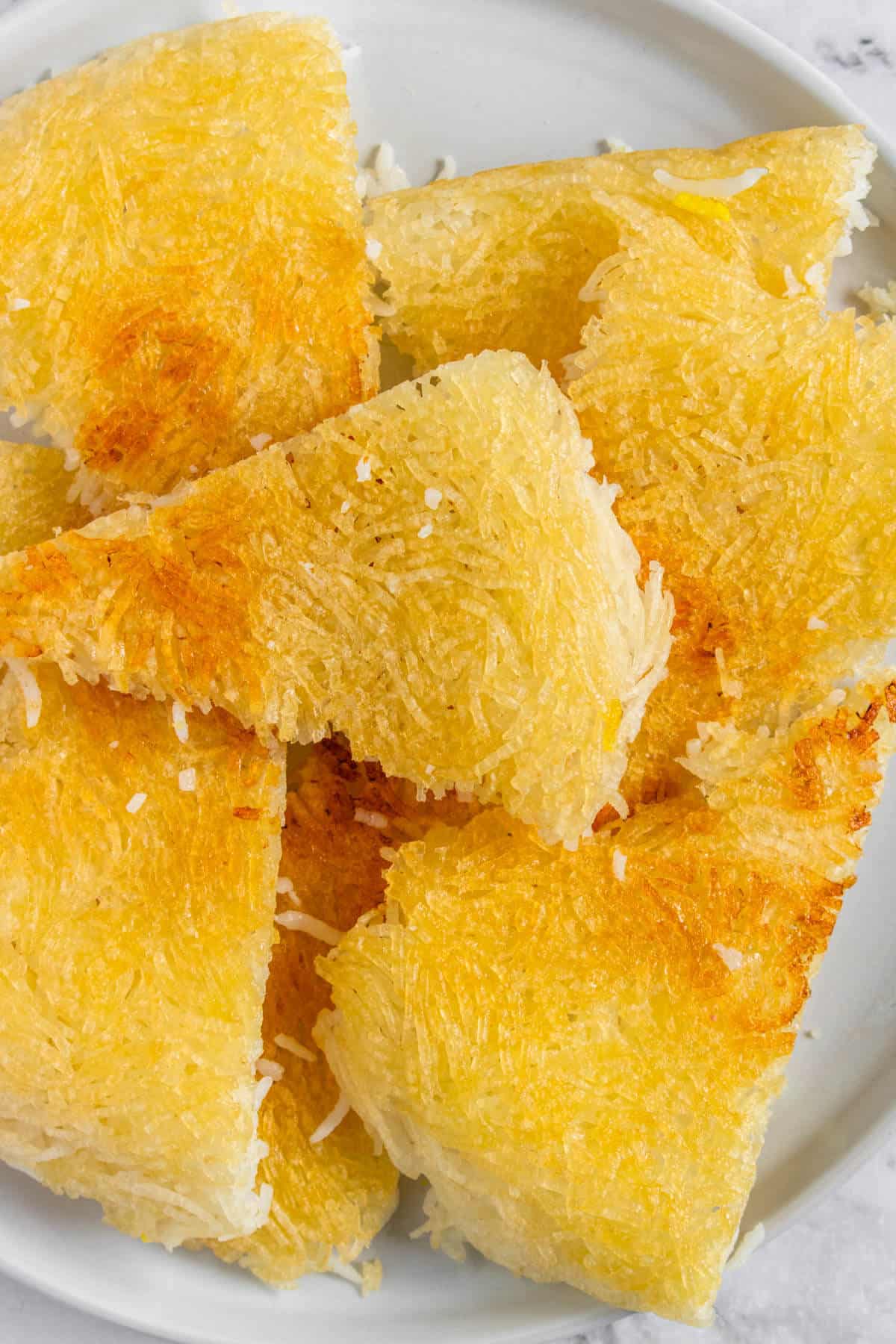
What is Saffron?
Saffron otherwise known as liquid gold is a spice from the flower of Crocus sativus. It's more expensive than gold by weight and the most expensive spice in the world. Saffron is in a lot of Persian dishes which brings out a beautiful aroma, colour and flavour.
My mother taught me to grind the saffron threads using a mortar and pestle so it becomes a grainy powder. As Saffron is quite expensive, it's important to understand a little bit goes a long way.
How to use Saffron?
- The best way to use Saffron is to firstly grind the saffron threads using a mortar and pestle so it becomes a grainy powder.
- You then add a small amount of the powder, say ¼ teaspoon, into a small bowl or glass with a few tablespoons of boiling water and stir.
- Allow it to infuse for 10 minutes, you will see the beautiful colour and aromas bursting out! Once the saffron has bloomed, you can then drizzle this into your food or rice while cooking it
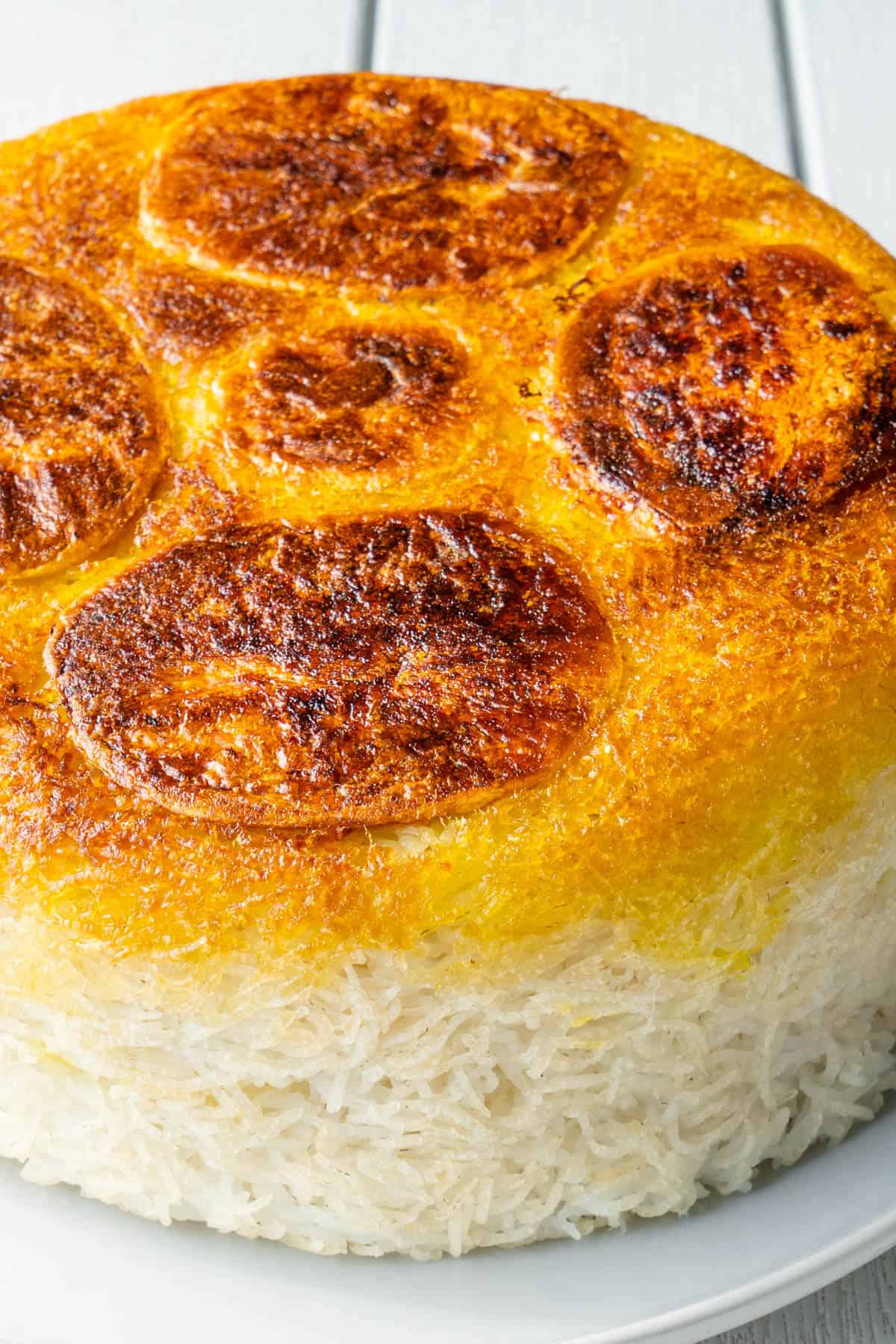
Tips & Tricks
- Make sure you are using a non-stick pot. This is super important otherwise your rice will stick to the pan
- Ensure you wash the basmati rice thoroughly. The water should run clear
- When you drain and rinse the rice, don't have the water pressure on too high as you don't want to break up the rice or make it mushy
- Don't be shy when adding olive oil. The oil will help make a golden crust
- The most important step of all, cook on low heat, nice and slow for 45 minutes. Rushing the rice can burn the bottom. You want it to become a thick and crispy golden Tahdig
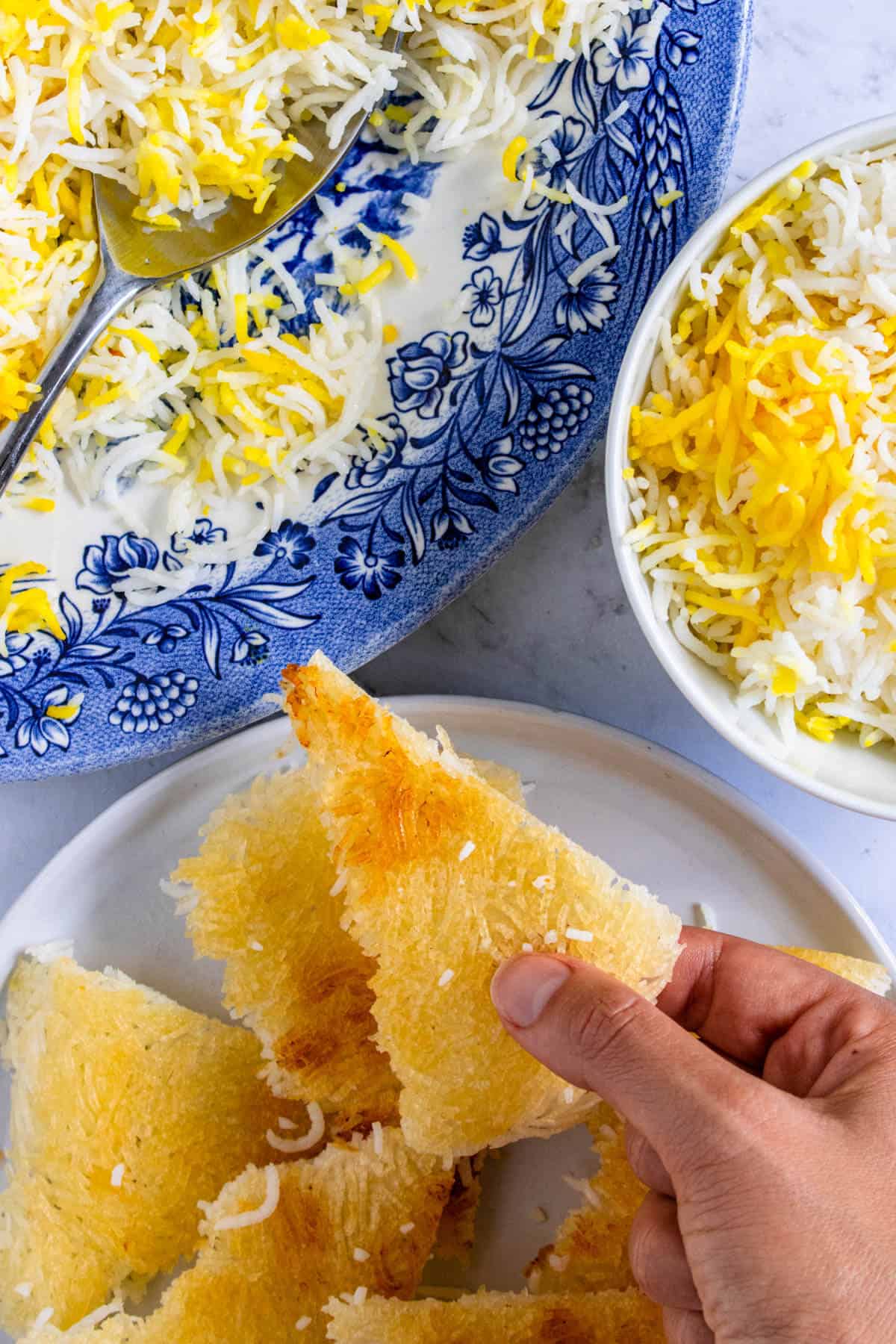
More Persian Recipes
- Barbari Bread (Persian Flatbread)
- Persian Ice Cream (Bastani Sonnati)
- Salad Olivieh
- Sabzi Polo (Persian Herb Rice)
- Kashke Bademjan (Persian Eggplant Dip)
- Shirazi Salad
- Mast o Khiar (Persian Cucumber Yogurt Dip)
- Lubia Polo (Green Bean Rice)
- Mirza Ghasemi (Smoky Eggplant Tomato Dip)
- Persian Noodle Soup
I love seeing your creations and remakes, so be sure to rate the recipe, comment and share your Persian Rice with Tahdig photo on Instagram so I can share the love!
Recipe
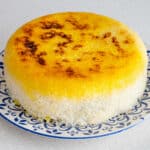
Persian Rice with Crispy Tahdig
Video
Ingredients
- 3 cups basmati rice
- 8-10 cups water
- 2 heaped tsp sea salt
- 2-3 tablespoon extra virgin olive oil
- **Optional Saffron water (see above saffron section on how to make this)
- **Optional You can also use a thinly sliced potato or flat bread such as lavash or Lebanese bread for the Tahdig.
Instructions
- Place your basmati rice in a non-stick cooking pot and wash the rice several times under a running tap (approximately 4 - 5 times). You want the water to run clear and not misty anymore
- Fill the pot with clean water (about 8-10 cups) and add the salt. Boil on a medium-high heat for 10–15 minutes to partially cook the riceIf there is white foam on the top of the water, carefully spoon it out and disregard
- When the grains of rice are aldente, drain the rice through a colander or fine mesh sieve. Carefully rinse under cold water. Don't have the water pressure too high
- Add the olive oil to the bottom of the pot. If using potatoes or flatbread for the Tahdig, place them in the pot in an even layer. Add the cooked rice back to the pot and using the handle of a wooden spoon or tablespoon, make holes into the rice down to the bottom of the pot. These will act as air pockets***Optional, If you’re adding saffron, add a few spoons of the saffron water at this time also
- Wrap the lid with a clean kitchen towel, add a splash of water to the pot and place the lid on. Cook on the lowest heat for 45 minutesTo serve, remove the lid and place a large dish or serving platter on the pot and flip the pot upside down. Carefully lift the pot and reveal your beautiful Persian Rice with Crispy Tahdig!

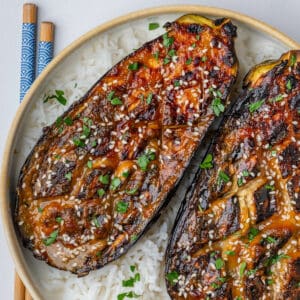
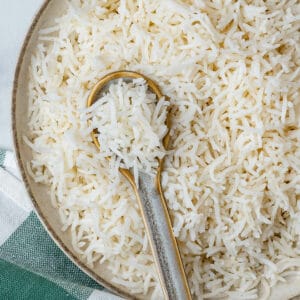
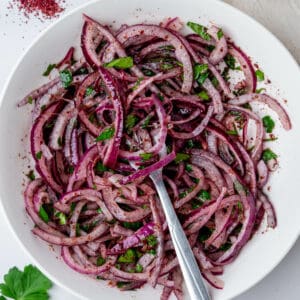
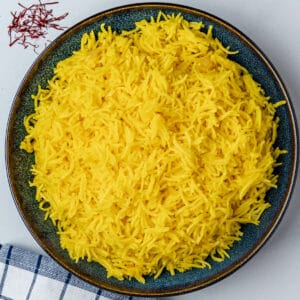
Donna
Can you make it with brown rice?
Ayeh
I havnt tried to make Tahdig with brown rice to be honest as the cooking technique is quite different and not the same texture to become as fluffy xxx
Karina
Will just a splash of water be enough once you put the rice back in the pot? I’m worried the rice will all burn if cooling for 25 more min.
Ayeh
Yes dear as you're steaming it and it should be cooked on a very low heat. also make sure its in a non stick pan x
Tina Boldman
Mine was beautifully golden on the bottom and slid right out. The problem I had was that it wasn't set up, it fell apart. Did I dry it out too much?
Ayeh Manfre
Do you mean the tahdig fell apart? To make a nice thick and crunchy tahdig, make sure to cook for at least 45 minutes on the lowest temperature so it cooks slowly and will ensure you have a thick crust xxx
Kim
How do you reheat leftover Tahdig?
Ayeh
its best to reheat the tahdig back in the same pot to get It crispy again. Add a little extra oil and cook for 5-10 mins on medium-high. xx
Amy
Hello, I was wondering what type of pot you use? Should it be non-stick? Thanks
Ayeh
Hi Amy, yes dear best on a non stick 🙂 ill add that to my tips now xxx
Resh
I was unsuccessful 🙁 my tahdig stuck to the pan
Ayeh
Oh no, did you use a non-stick pot?
maya
if i did this recipe but put a yogurt/saffron rice mixture on the bottom of the pan instead of olive oil, would the tahdig still cook correctly ? love your website ❤️❤️
Ayeh
That's a different type of tahdig but yes of course. The recipe is a little different though xxx
christi gebhart
Hi - Is there any way you can post the recipe for the tahdig with yogurt? Thank you!!
Ayeh Manfre
Oh yes, I have to share that recipe!
Summi
I don’t have non stick, can I use cast iron skillet?
Ayeh
I usually recommend a non-stick pot as it can stick on the bottom easily lovely. I havnt tried a cast iron skillet though personally x
Cindy
I was taught to use a dish towel between the pot and the lid. Is it ok not to use the dish towel?
Ayeh Manfre
Yes you can definitely do this dear 🙂 I do it with some pots depending on their lid xxx
Sharen
Have you tried cooking brown basmati rice this way?
TIA
Ayeh Manfre
I haven't tested it actually lovely 🙂
Scott
Love it 5star
Eric
Why do you say a splash of water instead of a specific amount? Can you offer guidance on this? Thank you.
Ayeh Manfre
Yes sure, about 1 tablespoon x
Pauline
What kind of toppings can be used after you flip it? Or is it just eaten plain?
Ayeh Manfre
We normally serve it with Persian stews or kebabs, but you can also serve with curry, stir fry, any dish really 🙂 I'll be posting a Persian stew soon this week x
Grit
A former persian colleague cooked this rice for us and it was a epiphany for all of us around the table! I remember, that Ilona took not only oil, but also butter to create the crispy surface of the rice. Meraviglioso!
Ayeh Manfre
Yes you can use butter too 🙂 So So yum!
C Jordan
My friend had a friend from Iran. He made a similar dish using sugar potatoes sliced thin shredded carrots and rice saffron
I lost the recipe and she longer sees him. Have you heard of such a dish. I think it has oranges too zested. Thank you
Ayeh Manfre
Oh yes! I love that dish, its a carrot rice. I need to share the recipe 🙂
Charlie
Can this be made in the rice cooker?
Ayeh Manfre
I must admit I havent tried using a rice cooker, but I have seen it be done x
Katherine
I made Tahdig for the 1st time last night. I was nervous that it would be hard to make bit it wasn't. The recipe was simple to follow and the Tahdig came out amazing. I will be making Tahdig frequently.
Ayeh Manfre
Your Tahdig looked absolutely amazing and you made me so proud!!
Martha
So you just the thin sliced potatoes @ the bottom of the pot before you put the rice back into the pot on top of the potatoes? You mixed the saffron w/water and pour it in the holes? Would coconut milk/water be good too instead of regular water? Thanks in advanced for your reply
Ayeh Manfre
Hi Martha, yes correct the potatoes are placed at the bottom of the pot when the oil is added, then the parboiled rice is poured back in. The saffron water can be drizzled around, doesnt have to be poured directly into the holes as it will slowly drip down into the rice while being cooked. We dont use coconut milk for Persian rice, its always water. Please let me know if you have any more questions xxx
Francesca
If I make this using half the ingredients in a smaller saucepan, will it turn out all right?
Ayeh Manfre
Sure thing 🙂